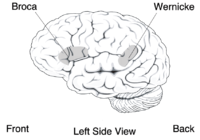
Photo from wikipedia
Students diagnosed with specific learning disabilities, autism, or emotional disturbance may also receive speech-language services as part of their individual education program. This article focuses on the use of telepractice… Click to show full abstract
Students diagnosed with specific learning disabilities, autism, or emotional disturbance may also receive speech-language services as part of their individual education program. This article focuses on the use of telepractice for providing speech-language services in schools. The benefits of telepractice are described, including the accessibility, efficiency, and preference of telepractice in delivering effective speech-language services. In addition, the implementation of telepractice services is outlined, strategies for troubleshooting are described, and two implementation checklists are provided.
Journal Title: Intervention in School and Clinic
Year Published: 2021
Link to full text (if available)
Share on Social Media: Sign Up to like & get
recommendations!